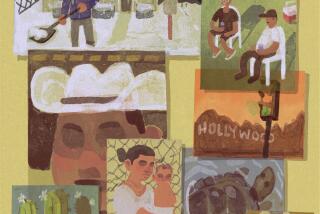Hamtramck Taking the Fast Lane to Hipness
- Share via
HAMTRAMCK, Mich. — In the smoky darkness of the old Polish Falcons Club, the mayor leans against a pool table and catches up on the latest gossip. He can hardly hide his disappointment. He has missed a surprise stop by the Cure.
Here, newlyweds once danced the polka while middle-aged auto workers relaxed over steins of Stroh’s. But the Dodge Main plant that employed generations of immigrants closed long ago, leaving the blue-collar town mired in a deep recession.
Tonight, the mayor isn’t fretting about economic revival, however, but the lost opportunity to see one of his favorite alternative rock bands. The polka club dusted off 18 months ago and reopened as the Motor Lounge, the hottest nightspot around Detroit. Mobs of the young and trendy now drink martinis and snake across the polished dance floor to techno music.
In a way, Hamtramck, bedeviled since the late 1970s by Detroit’s bad name, the auto industry’s painful restructuring and the migration to the suburbs, has found its own cure.
Long the domain of Polish Catholics, as no-frills a working-class community as Dundalk, Md., or Northeast Philadelphia, Pa., Hamtramck (pop. 18,372) is reinventing itself as an artsy, multi-ethnic hangout.
Once known mainly for its bakeries and sausage shops, the 2-square-mile enclave within Detroit now bustles with Thai and Indian eateries, coffee shops, lofts and funky bars. The Utne Reader, a politically correct magazine, declared it one of the 15 hippest places in the United States.
“We’ve had a big influx,” says Gary Zych, the newly elected mayor. He epitomizes the change: A bearded, 43-year-old sculptor who favors turtlenecks and teaches design, he just unseated the mayor of 18 years.
But Zych cautions: “We’re not creating an Alpine village. There aren’t any pretensions. It’s changing, but it’s the same in the sense that this really embodies the American Dream: You can still come here, make a living and find a sense of belonging.”
*
New immigrants continue to arrive, some from Poland but increasingly also from Arab countries, Albania and the Ukraine. Though the local Chrysler assembly plant is better known by its nickname “Poletown,” less than half of Hamtramck’s population today is Polish. A survey of schoolchildren found that 8% spoke Polish at home, while 19% spoke Arabic.
Across town from the butcher shops selling kielbasa, Saleh al Masmari, who moved from Yemen, advertises Halal foods at his new Mecca market.
“Our friends were here and they told us this was a good place to live,” says his daughter, Nawal, who teaches at a fast-growing Arabic school. “When one person hears about it, they tell their friends and neighbors.”
The word on Hamtramck--cheap rents, safe streets and old-fashioned charm--also spread quickly in the last few years among graduate students, painters, dancers and graphic designers.
They discovered large, sunny apartments renting for less than $350 a month and houses selling for $40,000--just a 15-minute commute from downtown Detroit. Local developers noticed the resurgence and constructed lofts above the awning-covered shops on Jos. Campau, the crowded, half-mile main street that still offers all kinds of Polish goods.
*
Filmmakers Charles Cirgenski and Janine Menlove, who just wrapped up “Stardust,” moved in at the beginning of the wave of artists 10 years ago. They had lost out bidding on an old firehouse in Detroit and, in a funk, decided to cheer themselves up with a hearty Polish dinner.
On Jos. Campau, they stumbled across a vacant flower shop. Today, behind the grimy, indistinct storefront stretches their sleek studio and apartment. Banana trees shelter a hot tub in the old greenhouse; upstairs, the rooms display antiques.
“It’s like old Hollywood here; it’s in a time warp,” Cirgenski says. “This is one of the few places where you can live and walk around and there’s not a highway in the middle of it.”
He likes to watch the “70-year-old blue rinses” do their marketing next to twentysomething couples in matching black leather jackets. Scattered among the discount clothiers, bakeries and produce markets are newer shops selling beads, coffees and used books.
But it’s the bars and nightclubs that draw most of the young suburbanites.
Lili’s 21, known for its Iggy Pop memorabilia, led the way with alternative bands during Detroit’s punk days in the late ‘70s.
Now, crowds line up every Friday and Saturday night there and at the Attic, which features blues. Motor Lounge, where DJs spin techno, the electronic dance music invented in Detroit, is so vogue that members of the Cure, the Verve and Marilyn Manson drop by after performances.
Despite its growing popularity, however, Hamtramck still has a long way to go to recapture the prosperity of its heyday.
Beginning in 1915, European immigrants, many from Poland, streamed to the Dodge factory that at its peak rolled a car off the assembly line every 30 seconds. By 1922, when the city was formally incorporated, more than 50,000 people had settled in tidy brick houses, opened shops and built churches.
Then, in 1980, the Dodge Main shut down, laying off the last 2,500 of a work force that had numbered 9,500 a few years earlier. Shops went out of business. Families left for the suburbs. The city’s morale sank as workers searched unsuccessfully for jobs and worried about living in the middle of Detroit, then known nationally as “Murder City.”
“It’s been time for a change for a long, long time,” says Gerard J. Dettloff, the city’s economic-development director. “We were doing some tough treading. But we managed to get through, and what really has helped is the young influence.”
Perhaps as much a measure of Hamtramck’s emergence as any new nightclub was the surprise mayoral upset.
Swept on a tide of newcomer support, sculptor and professor Zych defeated nine-term incumbent Robert Kozaren by nine votes. Kozaren, a towering figure who led the Hamtramck parades and greeted dignitaries from the pope to President Clinton, demanded a recount. But Zych prevailed.
Not all locals are equally excited about their hometown’s changing culture. Lorelei Niedzielka, 20, a bartender at the Holbrook Cafe, which was the private Polish-American Century Club until two years ago, remembers fondly her aunt’s wedding reception there. She complains that rents and crime are increasing.
“I had to buy three bikes this past summer,” says Joyce Schefke, 31, who also works behind the bar.
Still, they agree that after a tornado ripped through the region last summer, toppling trees and damaging hundreds of houses, old-timers and newcomers rushed to help each other.
“It made everyone come together,” Niedzielka says. “That’s how it should be; Hamtramck was always a melting pot.”
To Barbara Matoski, owner of the New Palace Bakery, it’s simply a return to the comfort of old traditions. Parents bring their children to her bakery to see the cake boxes tied with string hanging from the ceiling.
“They are rediscovering it,” says Matoski, who prides herself on baking the same “paczki” (rich jelly doughnuts) and coffee cakes.
“We never made muffins from a a mix,” she explains. “I think that’s the charm--you try everything, then you come back to the old-fashioned ways.”
More to Read
Inside the business of entertainment
The Wide Shot brings you news, analysis and insights on everything from streaming wars to production — and what it all means for the future.
You may occasionally receive promotional content from the Los Angeles Times.










